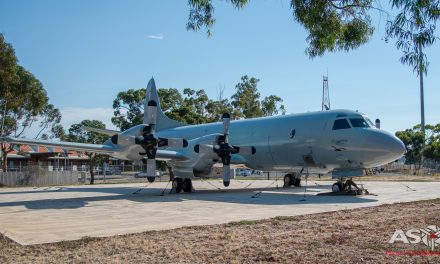

The Frontiers of Flight Museum is located at Dallas Love Airfield in Texas. Love Field was named in memory of Lt. Moss Lee Love. Lt Love was a US Army Pilot who was killed while flying his Wright biplane at North Island Air Station San Diego on the 4th of September 1913. With the tradition of naming airfields after fallen aviators, the US Army named its new training airfield ‘Love Field’ in honour of Lt Love on the 19th of October 1917. Lt Love had never been to the area, his mother was a Dallas native, however.
This aviation museum tells the stories local to and around the area of Dallas in Texas. It’s not hard to miss with the rear section of the retired Southwest Airlines Boeing 737 protruding out the rear of the hangar.
The museum was founded in November 1988 by William E. Cooper, Kay Bailey Hutchison, and Jan Collmer. It was originally located within a terminal at Dallas Love Field, today the museum occupies a 100,000-square-foot (9,300 m2) building at the southeast corner of Love Field on Lemmon Avenue. The museum is an affiliate within the Smithsonian Affiliations program.
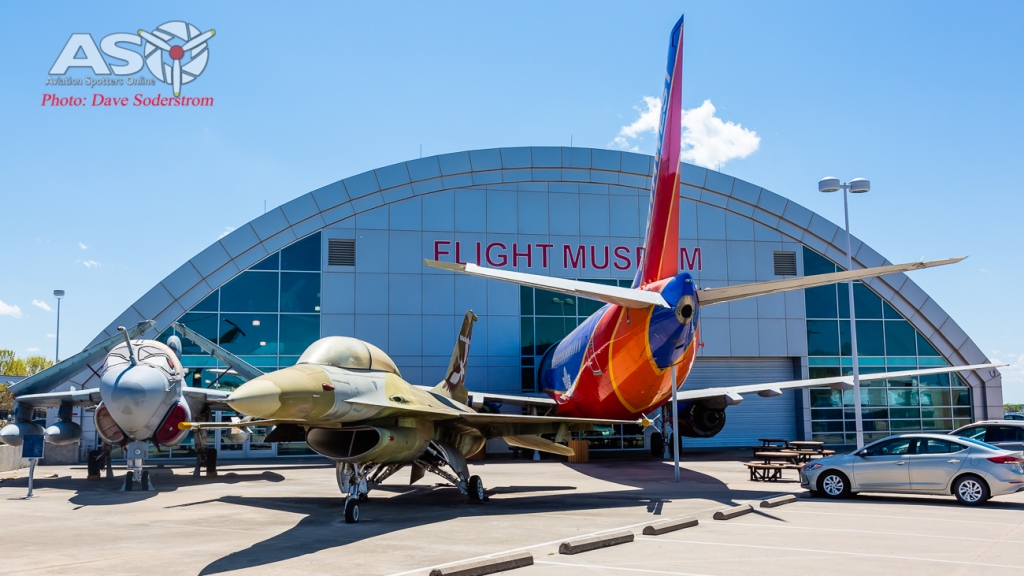
For my visit, I was looking forward to seeing some of the interesting types on display and aircraft that I personally hadn’t seen before.
As you pull into the museum’s car park with the Bell UH-1D perched beside the sign advertising the site, two ex combat jet types are also on display along with the aforementioned 737.
I have used the info from each aircraft on display on the museum’s website so as to get the information correct as possible with additional detective work from other sources.
Bell JUH-1h
Serialed 66-16977 it was converted from a UH-1D. The rest of the history of the helicopter is a little non-existent other than operating in the Vietnam war. It was on a pole in front of the Bell Helicopter plant at Hurst, before moving to the Frontiers of Flight.

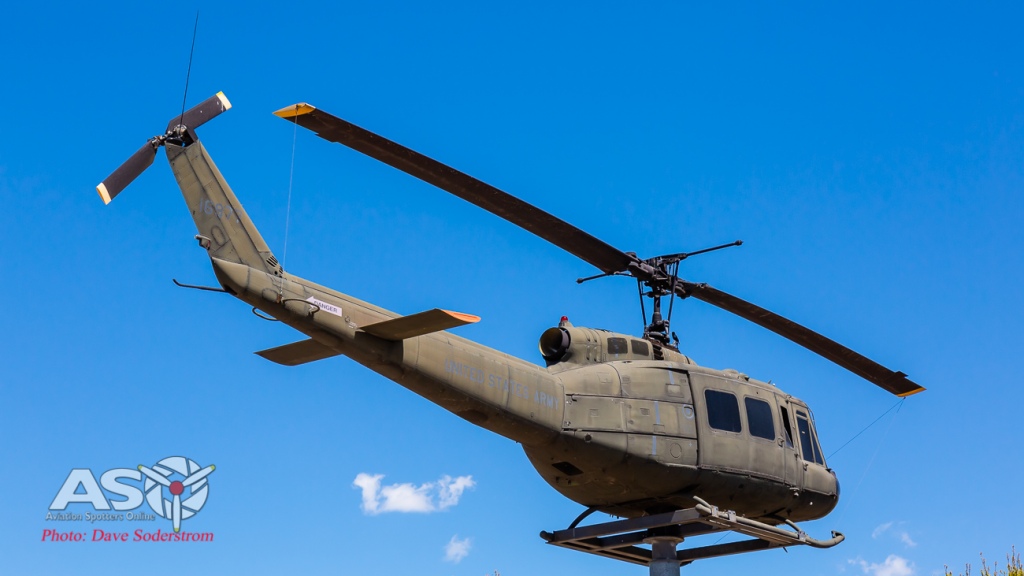
General Dynamics YF-16B 75-0752
This is the second pre-production aircraft. The aircraft was later modified with a General Electric J79-GE-119 engine for testing and was known as the F-16/79. This configuration was never taken in production. The aircraft was later restored to its original engine configuration and was used as a private-venture testbed for close air support and night/bad weather attack systems.

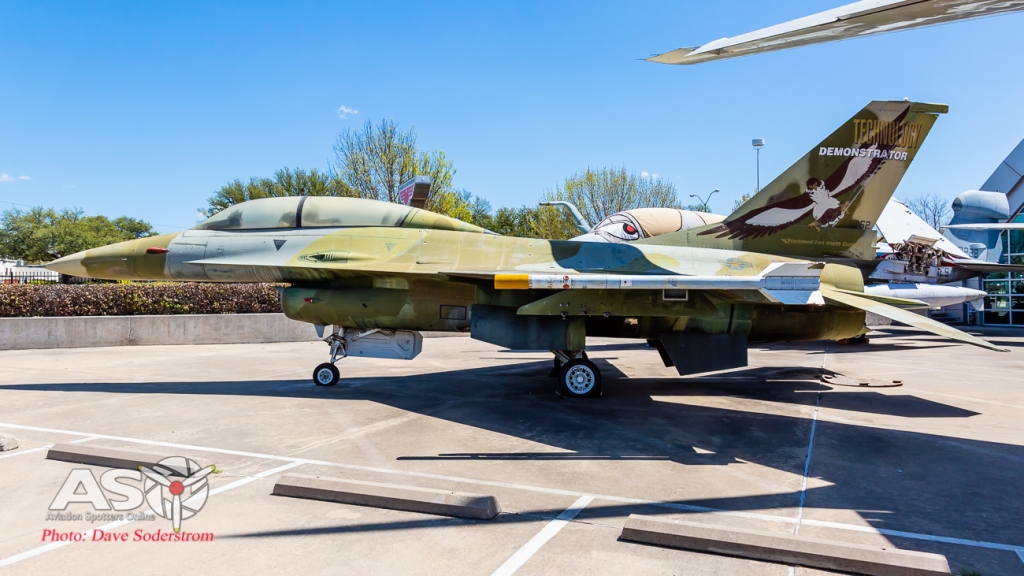


Northrop Grumman EA-6B Prowler
Derived from the Grumman A-6 “Intruder” airframe. The EA-6B had a long and distinguished career in the U.S. Armed Forces from 1971 until its retirement in 2019. Its primary mission was jamming enemy radar systems and gathering radio intelligence on enemy air defence systems. In addition, the EA-6B was capable of carrying and firing anti-radiation missiles (ARM), such as the AGM-88 High-Speed Anti-Radiation Missile (HARM).

The museum’s EA-6B, BuNu 16228, served with Marine Tactical Electronic Warfare Squadron 2 (VMAQ-2), known as the “Death Jesters”. VMAQ-2 was the last squadron in the U.S. military to operate the EA-6B “Prowler”. In March 2019, the squadron was decommissioned along with the last two Prowlers in active service, BuNo 162228 and 162230. The Frontiers of Flight Museum acquired EA-6B BuNo 162228, on loan from the National Museum of the Marine Corps, thanks to the assistance of the DFW Tailhookers. The aircraft arrived at Dallas Love Field on March 12, 2019.



Museum Displays
The Museum has some really excellent displays within the hangars. Below are some images showing the variety.

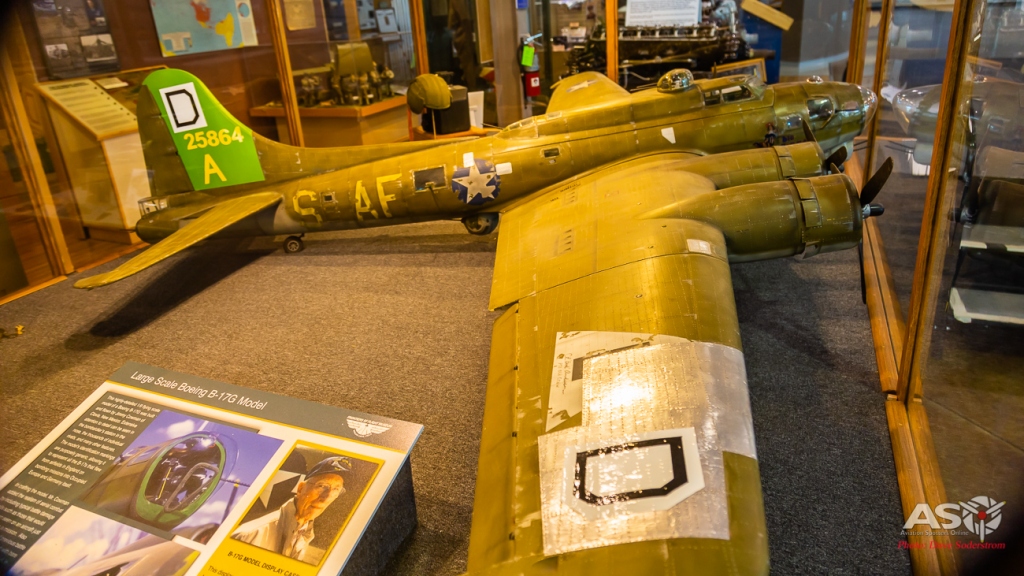
This huge remote control Boeing B-17 used to fly. its detail and painting are truly spectacular.
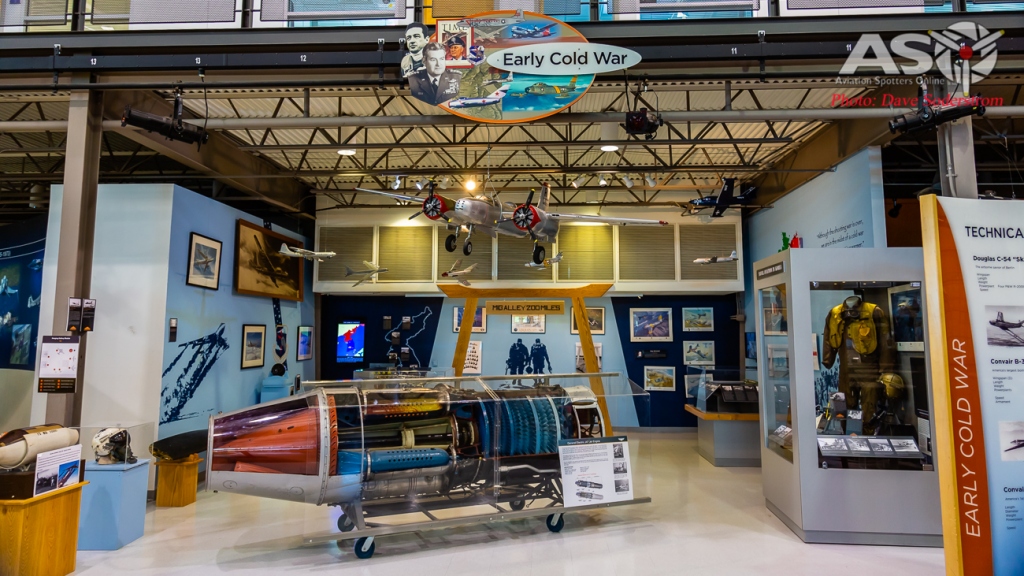
From the Earliest days of flight right through the museum tells the story with great displays of flying gear, engines, and much much more.

A pretty unique piece of history is this tyre which was flown on the Space Shuttle Endeavour.

This is the Apollo 7 Command Module. This module was used on the first manned Apollo flight. The module made 163 Earth orbits in 10 days 20 hours and 9 minutes travelling over 4,539,959 miles.

The quick opening outward opening crew hatch was a design feature of the Apollo 7 module after the tragic pad fire of Apollo 1 which killed the three astronauts within it.


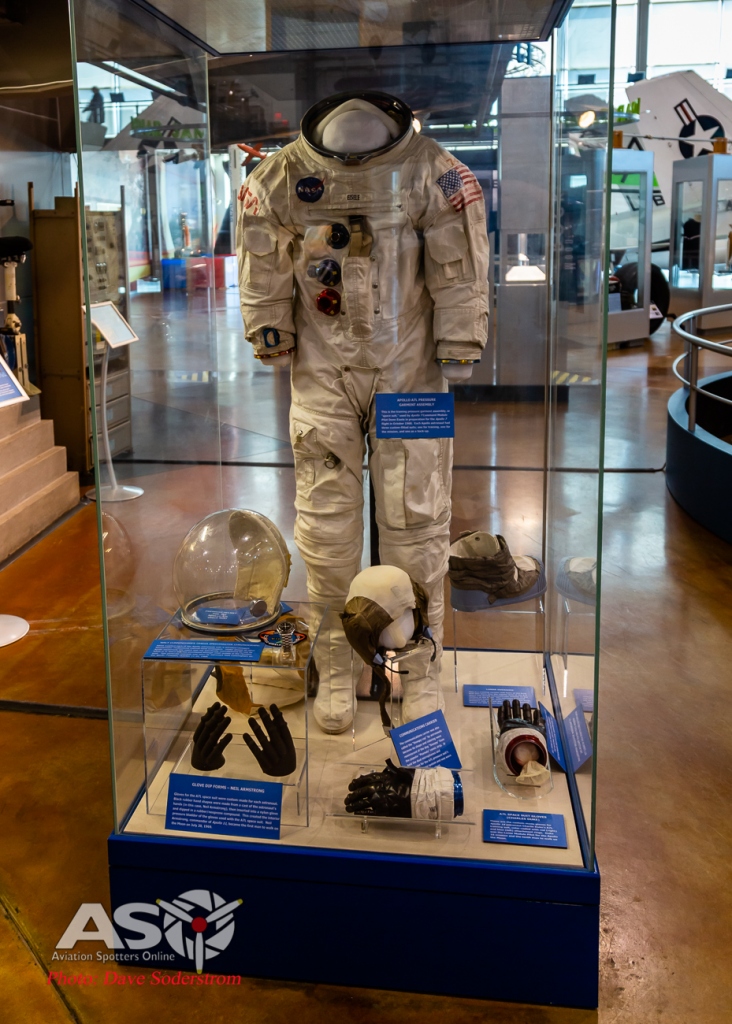

The story of Braniff Airlines is told on the uper level of the museum. With some great displays and pieces showing the rise and fall of theis vibrant airline.

De havilland DH.82 Tigermoth II.
An Australian abroad. One of the first exhibits I walked to was this ex Aussie Tigermoth which had flown on the Australian register as VH-PCC. Wearing the serial DE664 the aircraft was flown by the Royal Air Force. Post-war it migrated to Australia flying as VH-PCC until its export to the USA in 1974. Today it is marked with the US registration of N82AK.
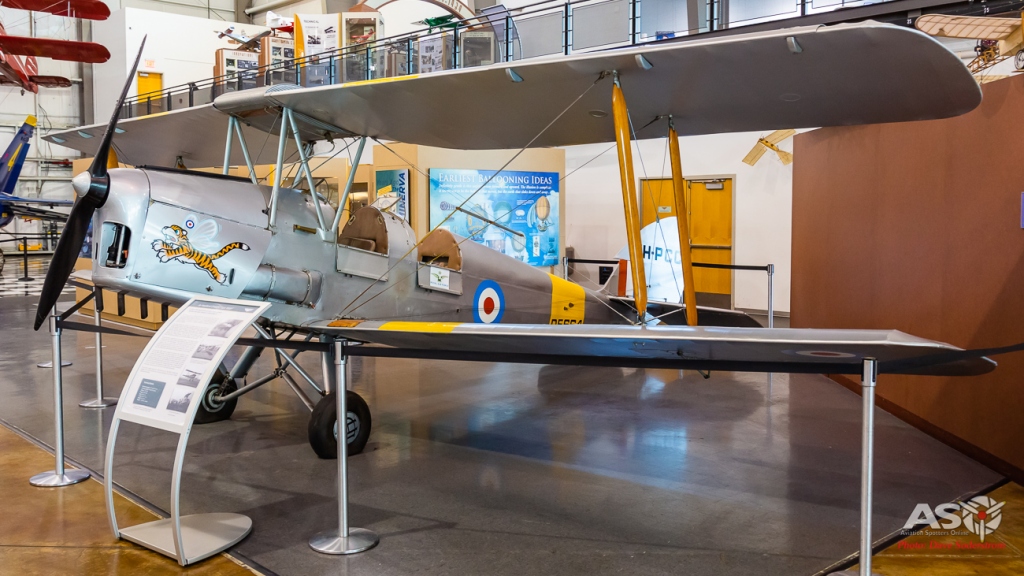

Boeing (McDonnell Douglas) F/A-18 Hornet
The Museum’s F/A-18C “Hornet”, BuNo 163435, has a long service history. It rolled out of the St. Louis McDonnell Douglas facility in 1987 and was transferred to the U.S. Navy Strike Fighter Squadron (VFA) 82 (nicknamed the “Marauders”) based at NAS Cecil Field, FL. From 1990 through spring 1991 the aircraft was deployed aboard USS America while it performed combat operations supporting Operation Desert Storm. Later, it served in VFA 81 (the “Sunliners”), based at NAS Oceana, VA. In June 2006 the Navy transferred the veteran aircraft to the Blue Angels.
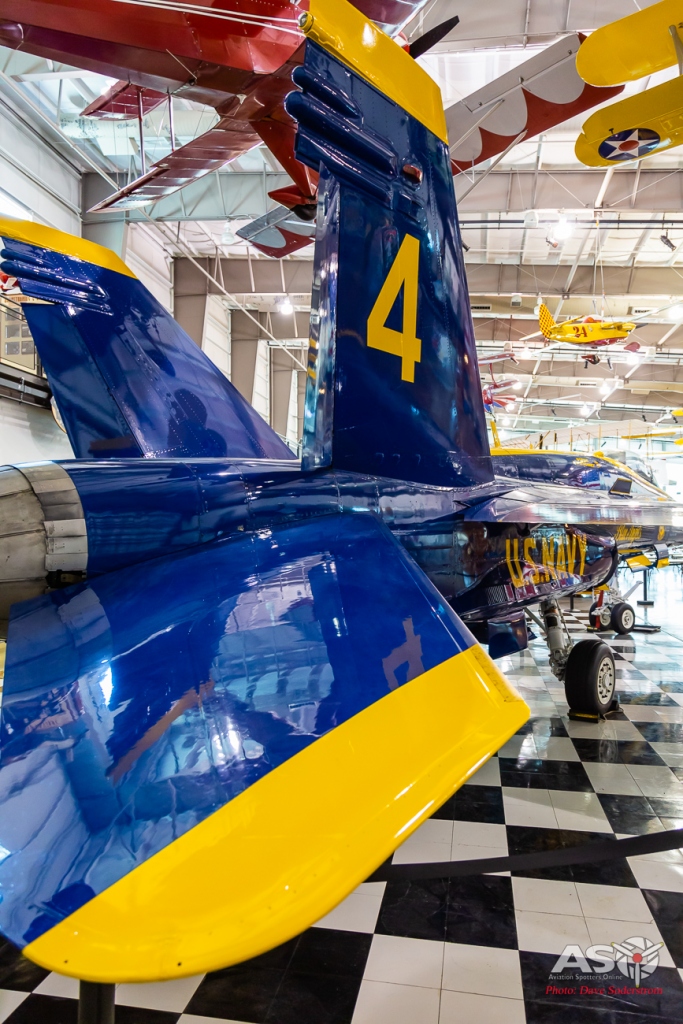 During its years of operation with the Blue Angels BuNo 163435 wore every number from 1 to 6. It wore the number 3 as it flew over Dallas-Fort Worth during Operation America Strong. It is carrying number 4 in honour of Admiral Pat Walsh, a resident of the Metroplex and a former Blue Angel pilot.
During its years of operation with the Blue Angels BuNo 163435 wore every number from 1 to 6. It wore the number 3 as it flew over Dallas-Fort Worth during Operation America Strong. It is carrying number 4 in honour of Admiral Pat Walsh, a resident of the Metroplex and a former Blue Angel pilot.
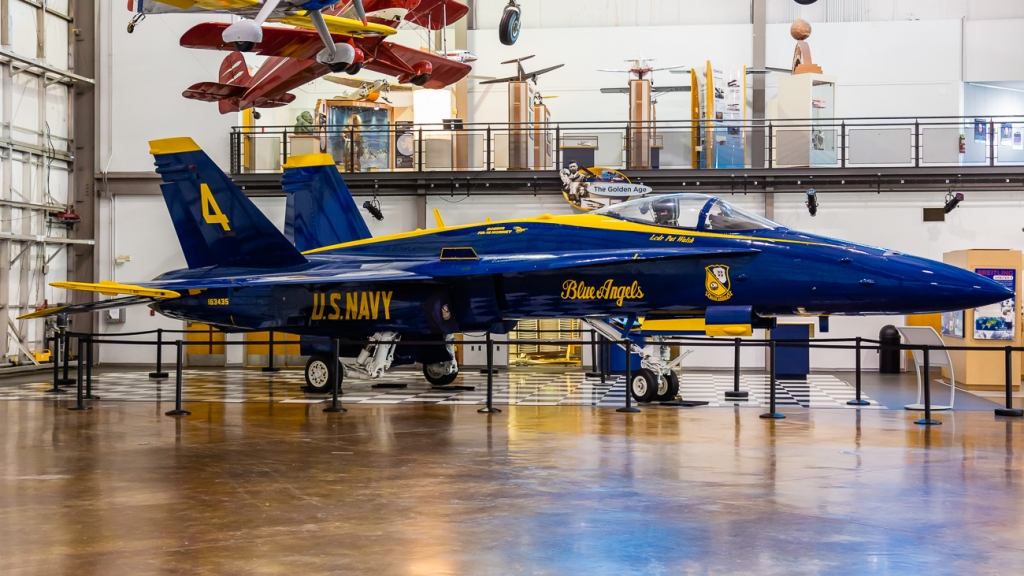
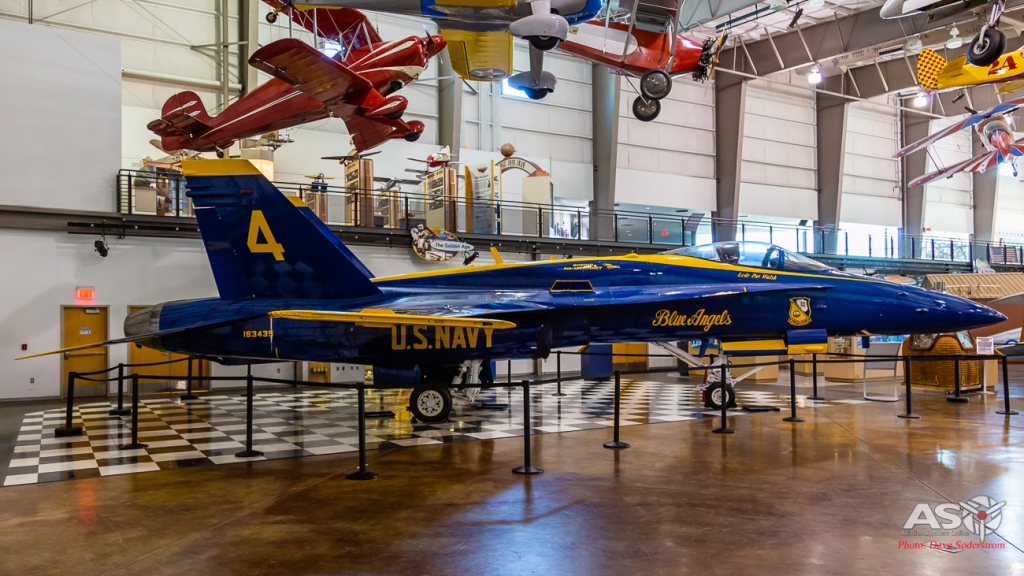


LearAvia Lear Fan 2100
One of the last aircraft designed by Bill Lear, the LearAvia Lear Fan 2100 is one of the first business aircraft constructed with carbon fibre materials. The radical twin-engine, single prop “pusher” design pushed the limits of engineering ingenuity. One of Lear’s favourite sayings describes this mammoth project well, “Don’t take a nibble…take the big bite!“ After Lear’s passing, his wife Moya honoured his final wish, took the big bite, and finished the project.

 Chance Vought V-173 “Flying Pancake”
Chance Vought V-173 “Flying Pancake”
The Chance Vought V-173 “Flying Pancake” is a one-of-kind aircraft that dates back to WWII. Designer Charles H. Zimmerman theorized that aircraft could fly at very slow speeds with an extremely low-aspect-ratio wing design. Zimmerman minimized drag by placing large-diameter propellers at the end of the circular airfoil wingtips, maintaining a uniform flow of air over the flat pancake’s single wing.
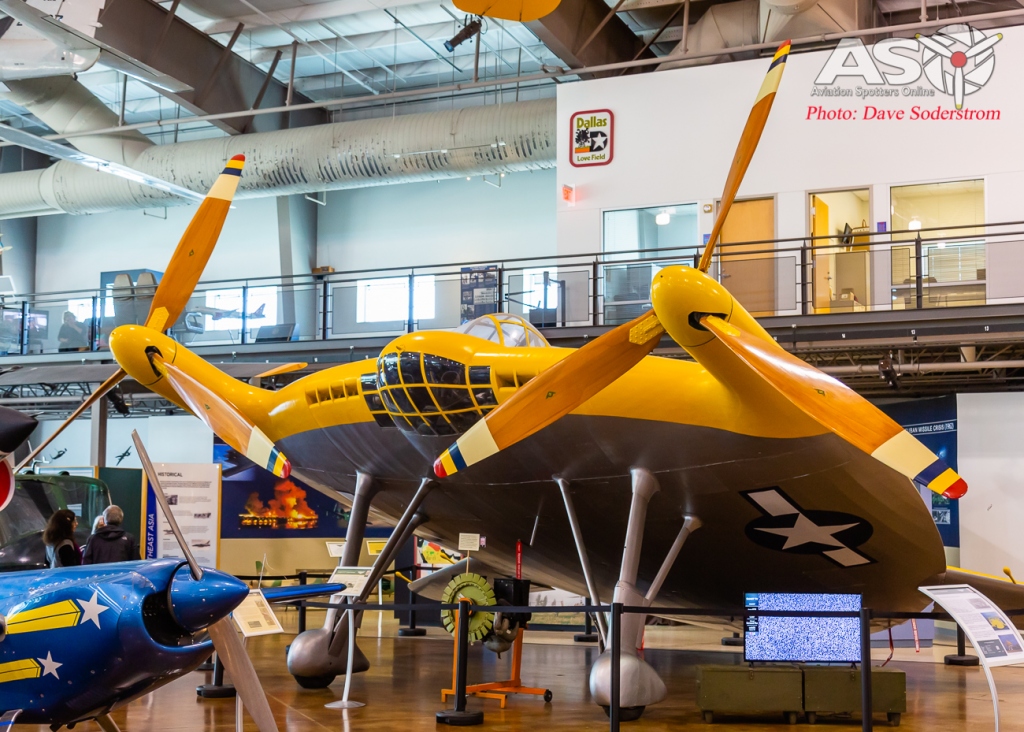
 Proudly restored by the Vought Aircraft Heritage Foundation, the “Flying Pancake” arrived at the Museum in 2012. The extensive restoration took over eight years to complete with more than 25,000 volunteer labour hours. This unique aircraft is on long-term loan from the Smithsonian National Air & Space Museum.
Proudly restored by the Vought Aircraft Heritage Foundation, the “Flying Pancake” arrived at the Museum in 2012. The extensive restoration took over eight years to complete with more than 25,000 volunteer labour hours. This unique aircraft is on long-term loan from the Smithsonian National Air & Space Museum.
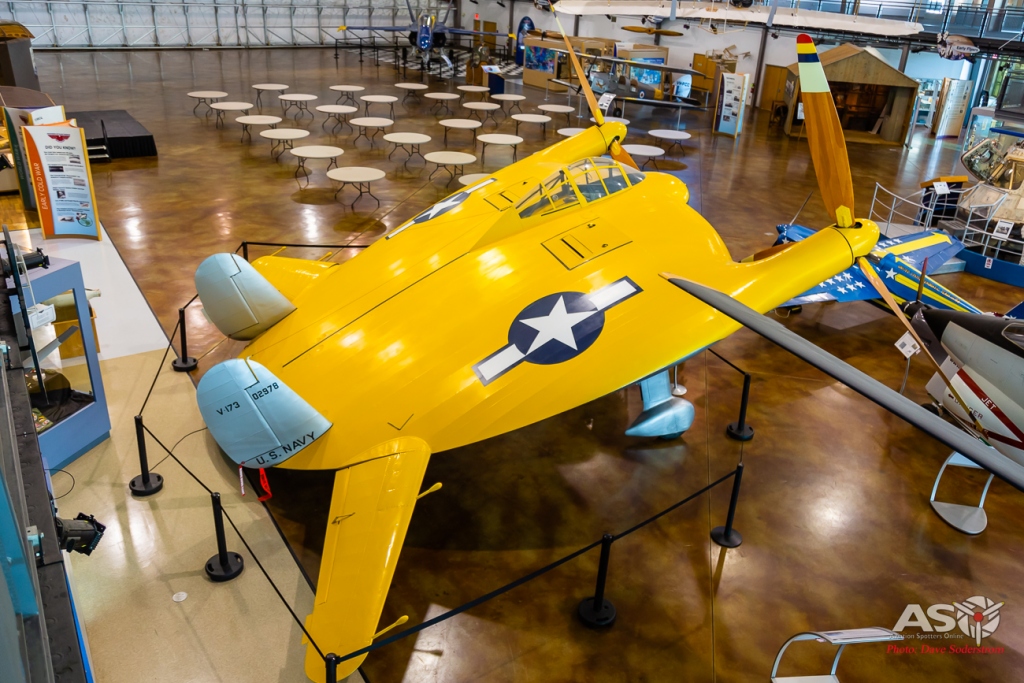
Vought RF-8G Crusader.
The Chance-Vought RF-8G “Crusader” is a supersonic US Navy jet, the reconnaissance version of the F-8 “Crusader” Navy fighter. Originally known as the F8U until 1962 when the Defense Department standardized military aircraft designations, the F-8’s wings pivoted by 7° out of the fuselage on takeoff and landing. As the last fighter jet to be armed with cannons as their primary weapon, the F-8 earned the nickname “Last of the Gunfighters.”

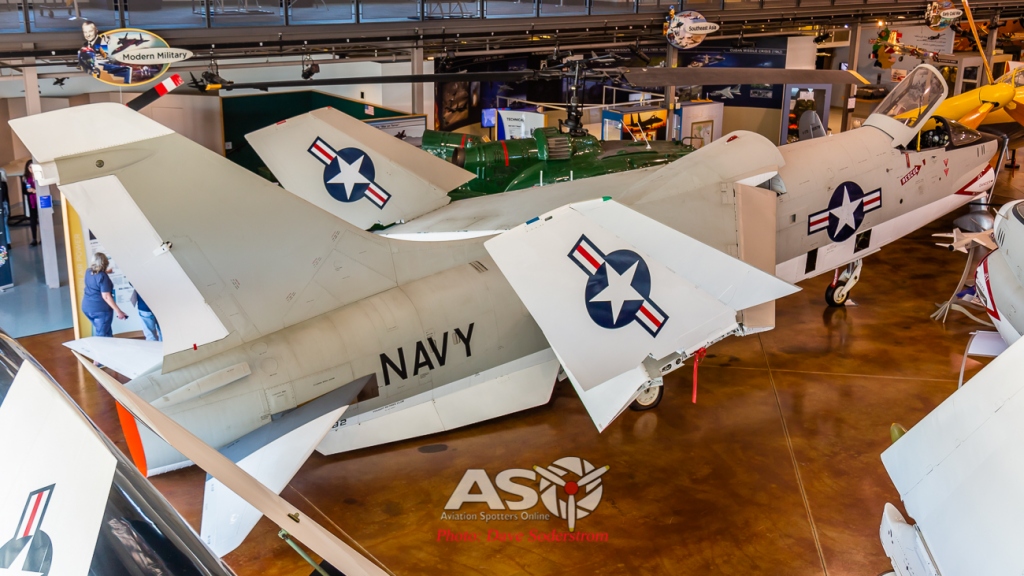
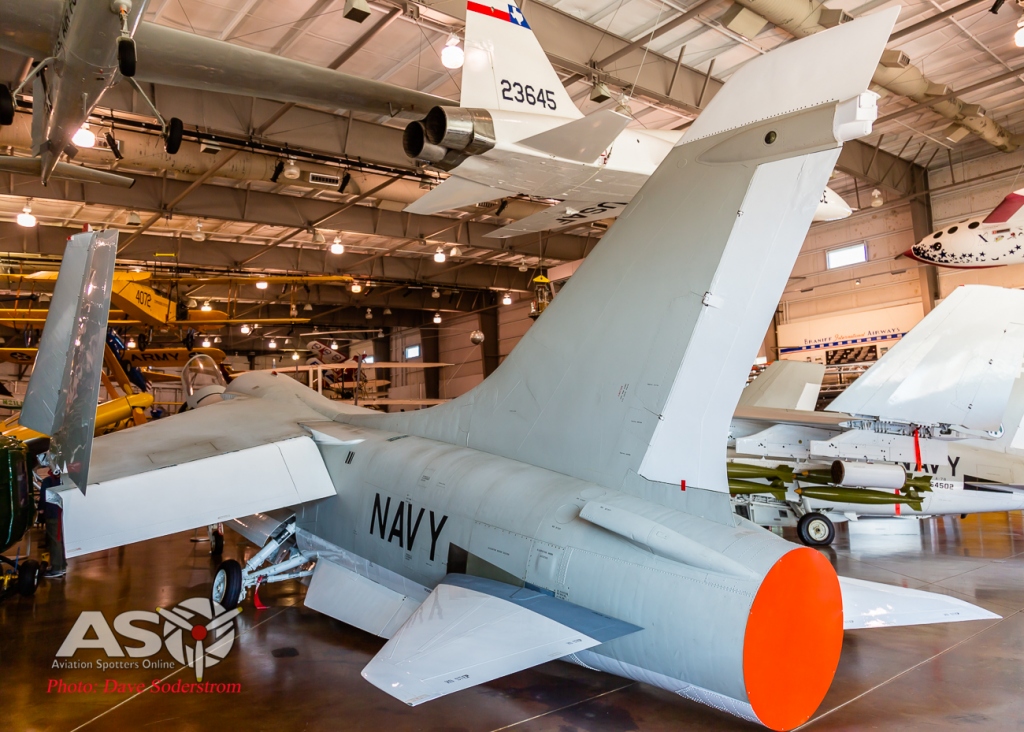
Rescued from the boneyard in Tucson, Arizona by the Vought Aircraft Heritage Foundation, our RF-8G “Crusader”, 146882, began life as an F8U-1P and came off the Vought assembly line as the 125th photo Crusader. After an extensive restoration by the Vought Aircraft Heritage Volunteers, the RF-8G enjoys a place of prominence on the floor of the Museum’s Main Gallery. It is on loan from the National Naval Aviation Museum in Pensacola, Florida.
LTV A-7B Corsair II
The LTV A-7B “Corsair II” is the second model of the subsonic, light attack aircraft used primarily for ground support by the US Navy during the Vietnam War. The A-7 carried 15,000 lbs. of munitions and featured a heads-up display (HUD), an inertial navigation system (INS), and a turbofan engine. The first squadron of A-7Bs deployed aboard the USS Enterprise in 1969.

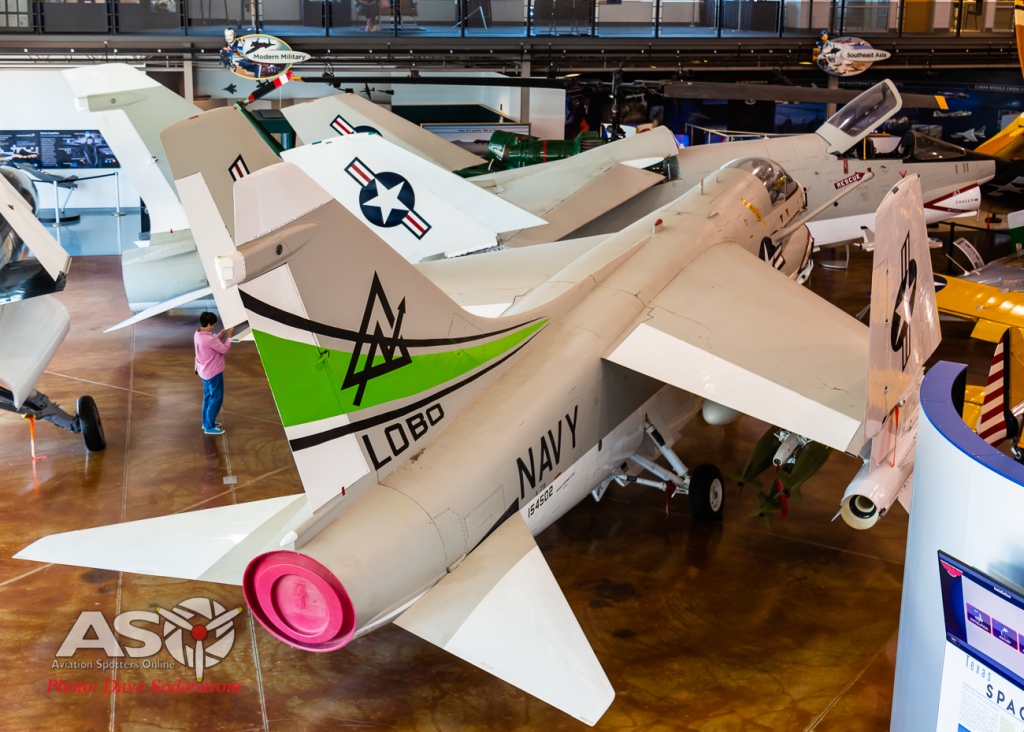

This LTV A-7B “Corsair II” 154502 last served with the US Navy Attack Squadron VA-46. After being retired from active service, this aircraft served as a prop to practice moving damaged aircraft off a runway. Volunteers with the Vought Aircraft Heritage Foundation (VAHF) brought the aircraft to Dallas in July 1999. With extensive damage to the fuselage, wing, and tail and the cockpit stripped of instrumentation, the extensive restoration took over five years. The markings on the right side of the tail now pay homage to VAF-305 “Lobos”, a Reserve Squadron at NAS Point Mugu, California. The left side of the tail is the markings for the VA-205 “Green Falcons”, an attack squadron of the US Naval Reserve, based at Naval Air Station Atlanta, Georgia.
Ryan PT-22 Recruit
The Ryan PT-22 “Recruit” monoplane trainer met the increased training need for pilots and aircrews as US air forces rapidly expanded in the early 1940s. Because a military primary trainer spent at least half of its time practising landings and takeoffs with new pilots, designers removed the landing gear fairings called “spats.” This allowed for easier inspection and repair of the overworked landing gear. As the US Army Air Corps’ first purpose-built monoplane trainer, Ryan Aeronautical built over 1,000 PT-22s in 1941-42.
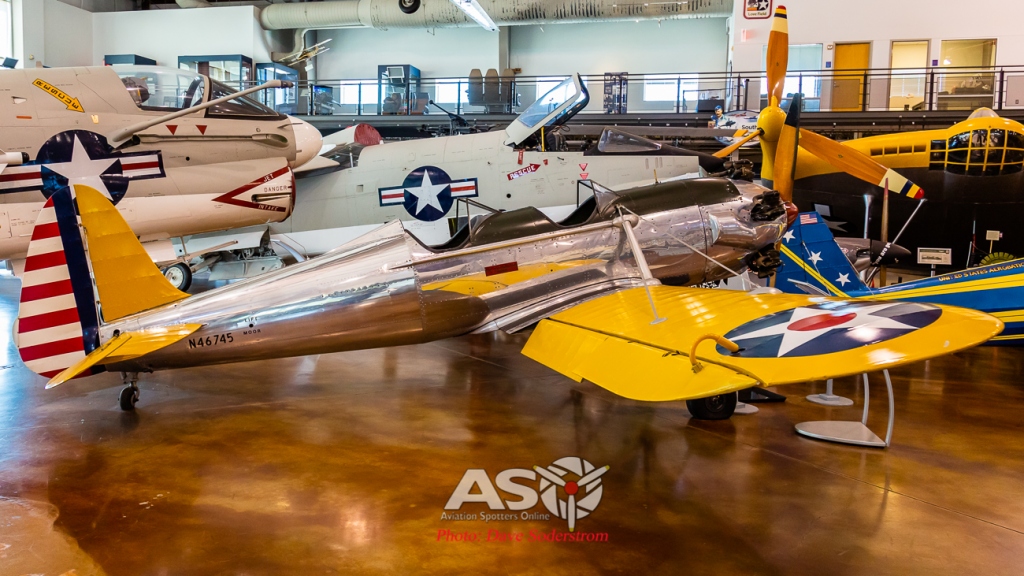
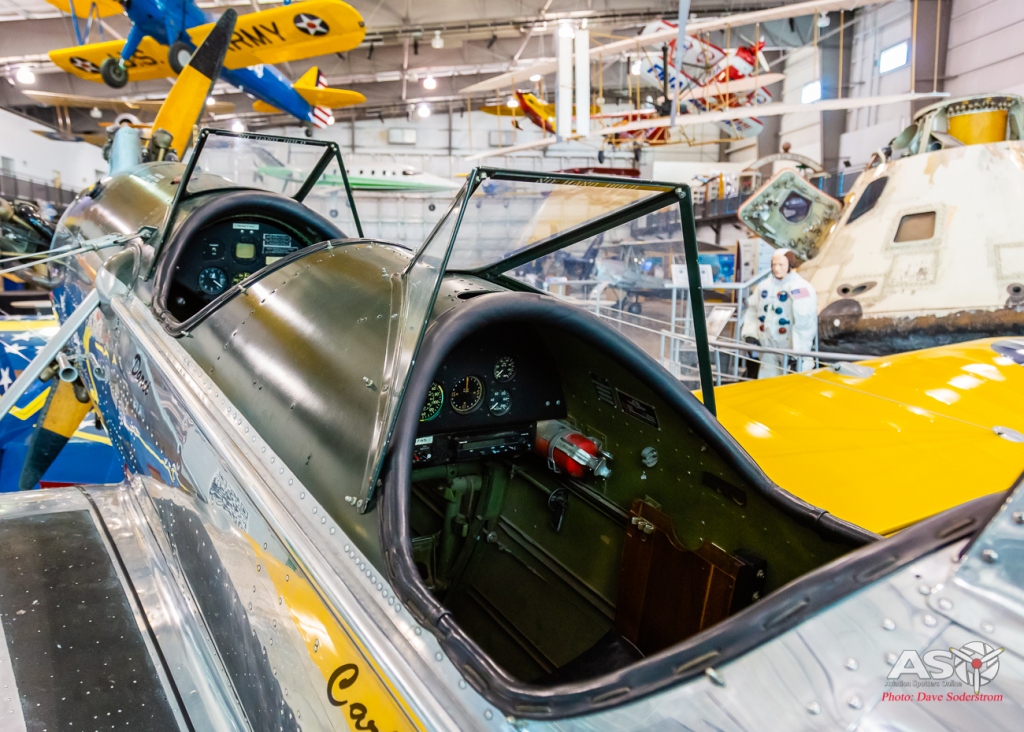
Boeing PT-17 Stearman
The Boeing/Stearman PT-17 “Kaydet” served as the primary trainer of the US military from the late 1930s to the end of World War II. Built as a private venture by the Stearman Aircraft Company, the two-seat biplane gained the reputation of being a rugged, easy to fly the aeroplane and became a favourite teacher to many pilots. When Stearman Aircraft Company became a subsidiary of Boeing in 1934, the aircraft’s official name became the Boeing Model 75, although most continue to refer to it as the “Stearman.”
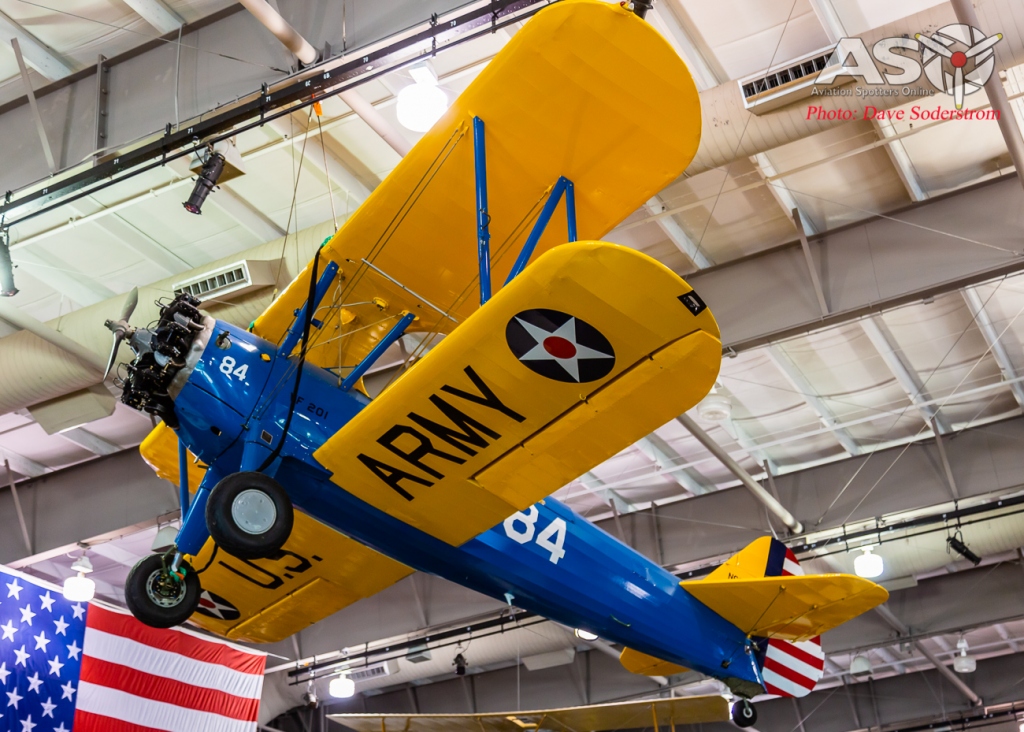 Following a complete restoration by Leroy Keener, owner Mr Rod Lawrence donated this beautiful Boeing/Stearman PT-17 “Kaydet” to the Museum with less than 100 hours on the airframe.
Following a complete restoration by Leroy Keener, owner Mr Rod Lawrence donated this beautiful Boeing/Stearman PT-17 “Kaydet” to the Museum with less than 100 hours on the airframe.
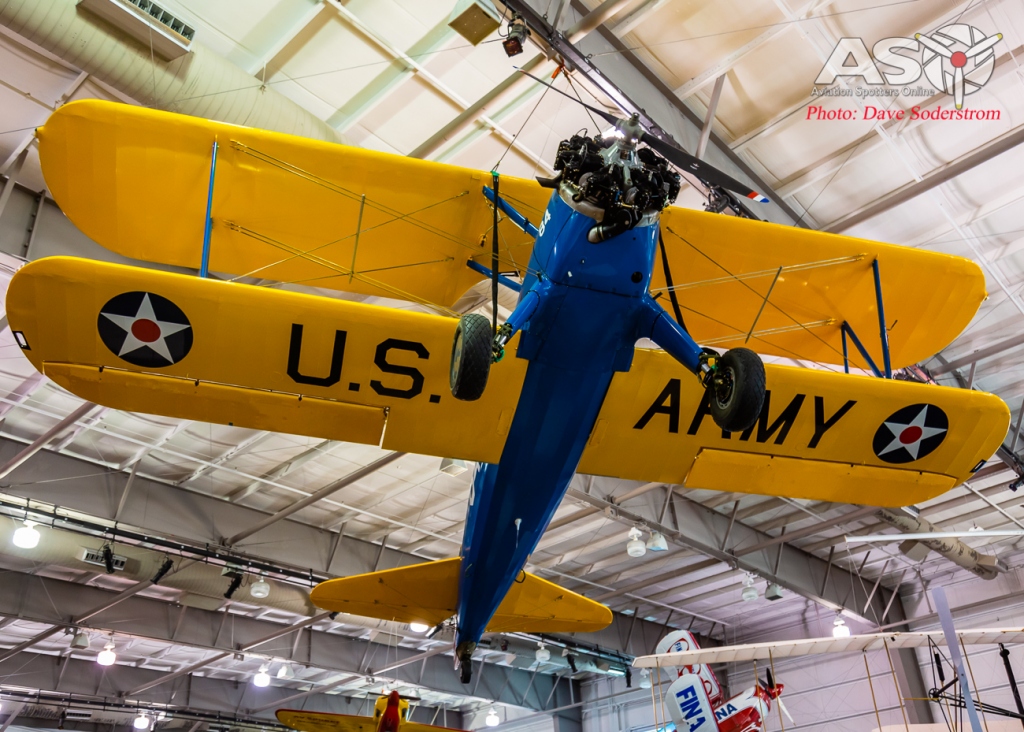
Curtiss Jenny
Many pilots in the US Army trained on the Curtiss JN-4D “Jenny” during World War I before being sent to combat in Europe. Because pilots shortened the JN “jay-en” designation to “jen”, most people referred to the single-engine, two-seat training aircraft as “Jenny.” When the war ended, WWI aviators hungry to fly again purchased surplus “Jennys” as private citizens at bargain prices, giving birth to the barnstorming era. During the 1920s, barnstorming pilots in their “Jennys” entertained with loops, tricks, and barrel rolls while giving rides to locals for a fee. As a result, barnstorming became the first major form of civil aviation with “Jenny” a big part of it all.
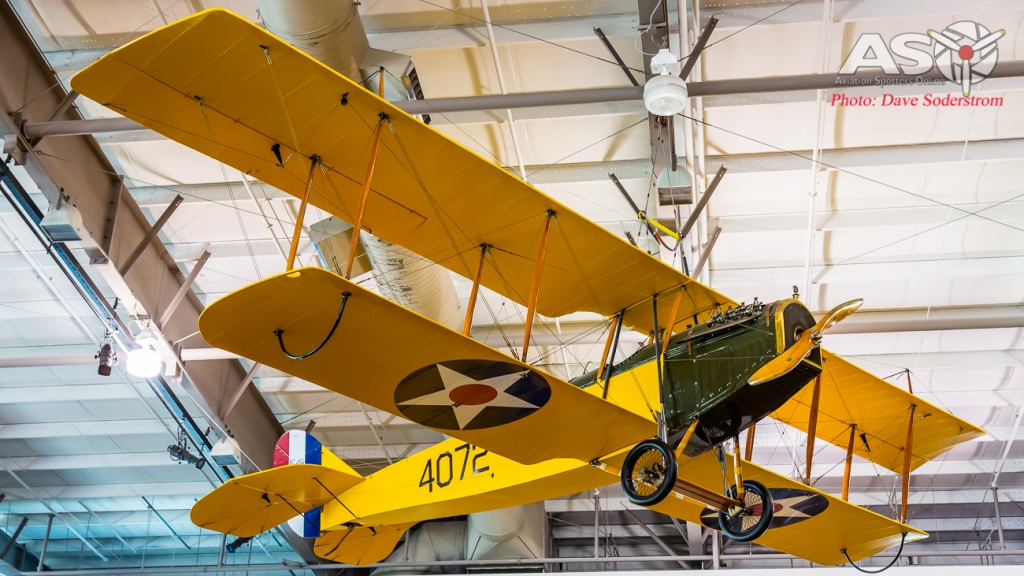 Built by Liberty Iron Works of Sacramento, CA in 1916 and shipped to Love Field in 1918, Curtiss JN-4D “Jenny” Serial #4072 is the fourth from the last built by Liberty. Following the war, a civilian purchased it with the registration NC 3769, which now belongs to another aircraft, minus the “C”. After a meticulous two-decade restoration, Phil Mintari and the family of Ingram, Texas, loaned this beautiful “Jenny” to the Museum. Even though it received an FAA Certificate of Airworthiness, it has yet to fly.
Built by Liberty Iron Works of Sacramento, CA in 1916 and shipped to Love Field in 1918, Curtiss JN-4D “Jenny” Serial #4072 is the fourth from the last built by Liberty. Following the war, a civilian purchased it with the registration NC 3769, which now belongs to another aircraft, minus the “C”. After a meticulous two-decade restoration, Phil Mintari and the family of Ingram, Texas, loaned this beautiful “Jenny” to the Museum. Even though it received an FAA Certificate of Airworthiness, it has yet to fly.
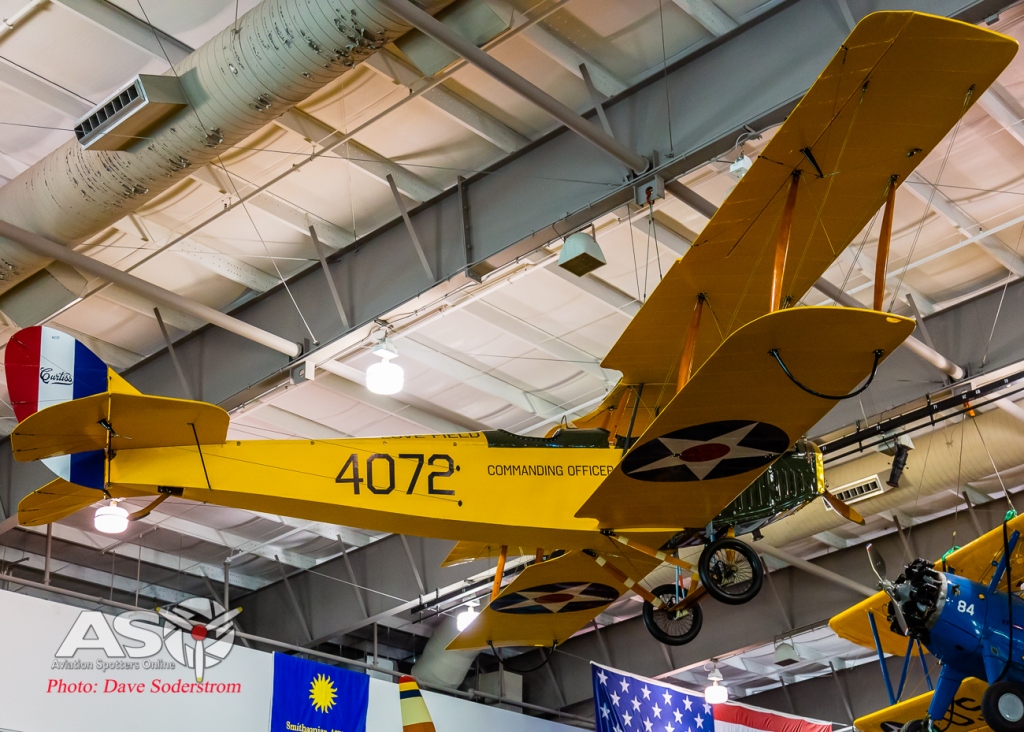
Texas Temple ‘Sportsman’
Developed and flown in 1927, the Texas Temple “Sportsman” is a light single-seat, high-wing monoplane. It proudly achieved many “firsts” when built. It is the product of the first man to design and build an aeroplane in Texas, George W. Williams, Jr., the first aircraft manufactured at Dallas Love Field, by the first commercial company licensed to sell aeroplanes in Texas. Experimenting with aircraft design since 1908, Williams formed the Texas Aero Manufacturing Company in 1911 in Temple, Texas.
 There were three Texas Temple “Sportsman” monoplanes produced, and the Museum’s aircraft is the last of the three, N987N. It is the only remaining example in the world. Jerry D. Ferrel, an avid pilot and veteran of WWII and Korea, discovered parts of the aircraft at Russell Field in Fort Worth. Over a nine-year period, he meticulously restored it piece by piece. Ferrel graciously flew his masterpiece to Dallas Love Field and donated it to the Museum in 1992 to preserve the history of the Temple, Texas monoplane.
There were three Texas Temple “Sportsman” monoplanes produced, and the Museum’s aircraft is the last of the three, N987N. It is the only remaining example in the world. Jerry D. Ferrel, an avid pilot and veteran of WWII and Korea, discovered parts of the aircraft at Russell Field in Fort Worth. Over a nine-year period, he meticulously restored it piece by piece. Ferrel graciously flew his masterpiece to Dallas Love Field and donated it to the Museum in 1992 to preserve the history of the Temple, Texas monoplane.
Shoestring F1 Racer
“Time Bandit” In 1949, Rodney Kreimendahl designed the Shoestring F1 Racer aircraft, a fast, nimble award-winning Formula 1 Class Air Racer. Considered one of the iconic midget racers, the Shoestring remains popular today in Formula 1 Air Racing.

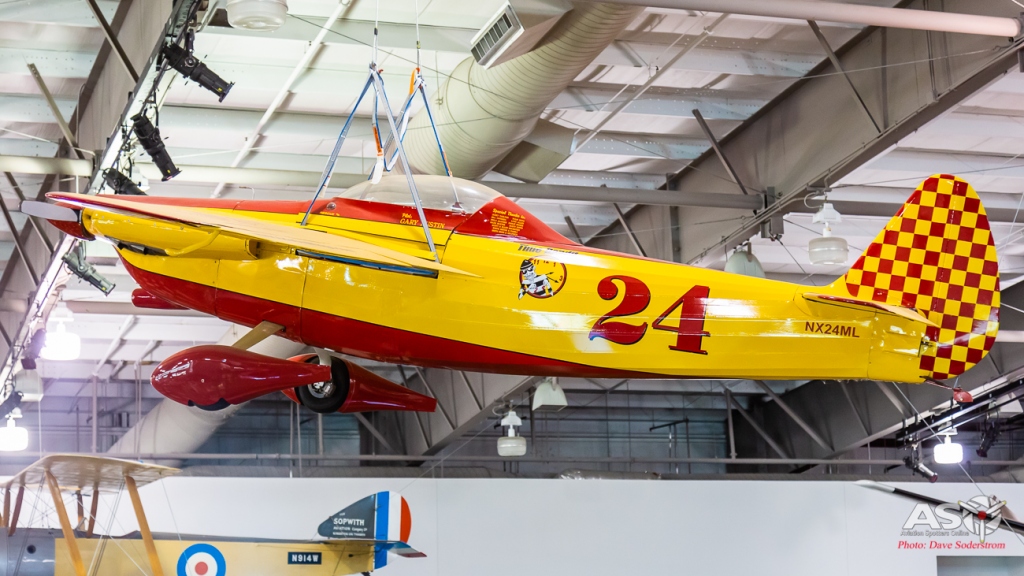
Laser 200
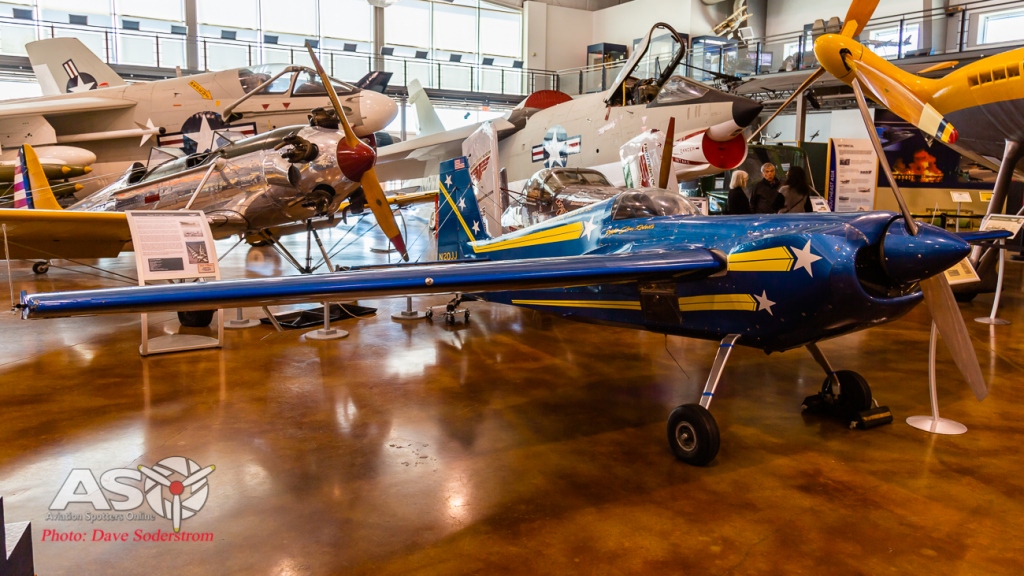
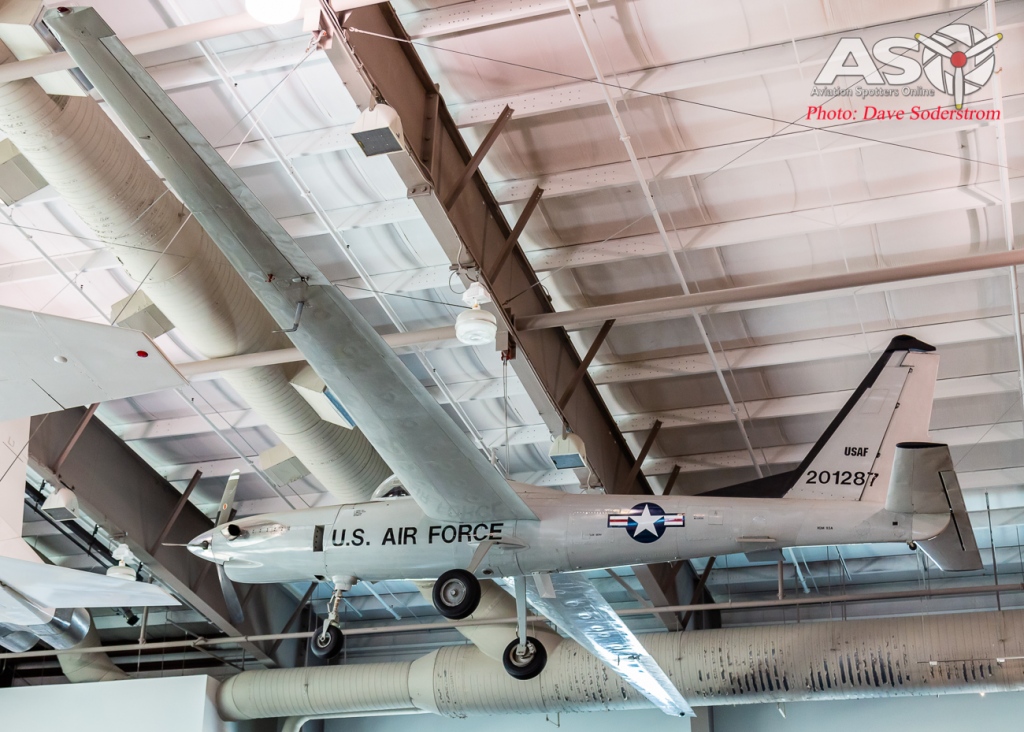

The E-Systems XQM-93A aircraft is part of the US Air Force’s early 1970s “Compass Dwell” program evaluating the possibility of high-altitude Unmanned Autonomous Vehicles (UAV) for use in the Vietnam War. As one of the competitors for “Compass Dwell,” LTV (later E-Systems) introduced its piloted L450F. The next prototype, the E-Systems ZQM-93A, could be piloted or unmanned. Unfortunately, the goal of cutting off supplies on the Ho Chi Minh Trail with unmanned eyes in the sky never materialized when the “Compass Dwell” program ended.
Chance-Vought SSM-N-9 “Regulus II”
 In June 1953, Vought received a contract to develop a supersonic successor to the “Regulus“ sub-sonic cruise missile. The new missile, named “Regulus II”, received the designation SSM-N-9. The first flight of a “Regulus II” took place in 1956. Two years later the government terminated the program in December 1958, in favour of the more advanced Polaris ballistic missile. After the project cancellation, Vought converted some of the remaining “Regulus II” missiles to supersonic target drones. These drones continued to fly until 1963.
In June 1953, Vought received a contract to develop a supersonic successor to the “Regulus“ sub-sonic cruise missile. The new missile, named “Regulus II”, received the designation SSM-N-9. The first flight of a “Regulus II” took place in 1956. Two years later the government terminated the program in December 1958, in favour of the more advanced Polaris ballistic missile. After the project cancellation, Vought converted some of the remaining “Regulus II” missiles to supersonic target drones. These drones continued to fly until 1963.
Bell UH-1
The Bell TH-1L “Iroquois” (Huey) served as a trainer and search/rescue helicopter for the US Navy. Produced in many different versions, the Bell “Huey” is the most popular among modern rotary-winged aircraft. The line of Bell Huey helicopters, produced in Fort Worth, Texas, evolved from the Bell Model 204, the first turbine-powered aircraft ordered for the US Army. First flown by Floyd Carlson at Fort Worth on October 22, 1956, the Huey became universally famous in all branches of the U.S. military service as well as with many other nations throughout the world. The L model Huey followed the B, D, and H models.


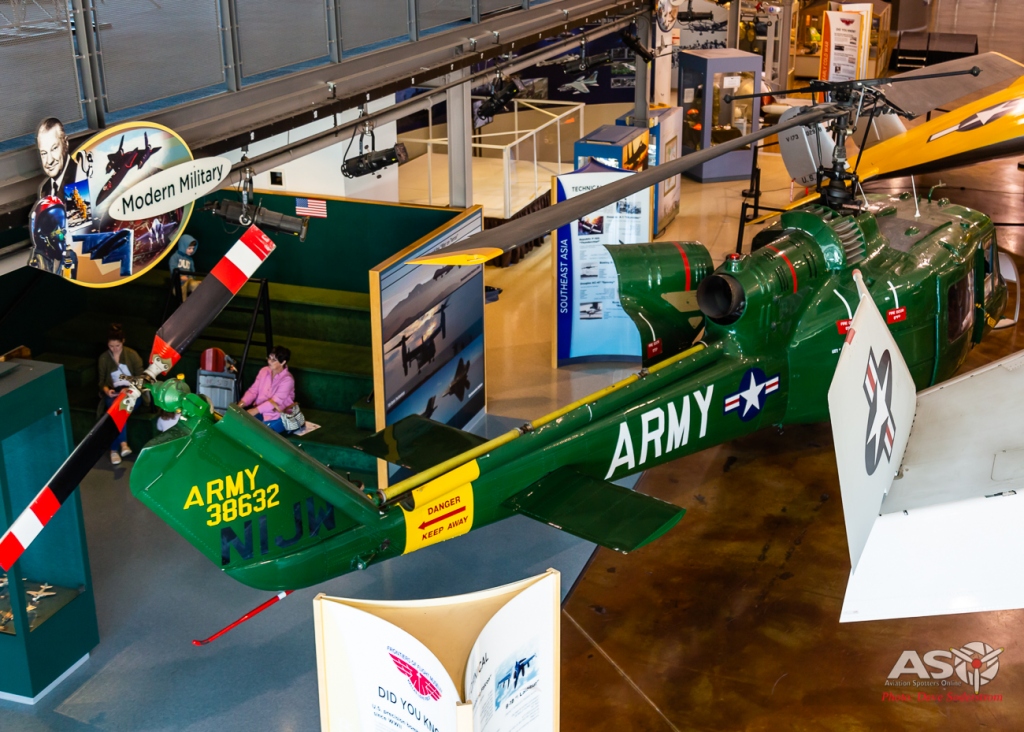
This TH-1L “Huey” Serial #157838 originally sported an original orange and white paint scheme. One of 45 produced, the TH-1Ls served in training and search-and-rescue (SAR) missions. Privately owned following retirement, the helicopter is refurbished in an Army green livery and flew for seven years before Jim and Alinda Wikert of Dallas generously donated it to the Museum’s collection.
Northrop T-38A “Talon”
The first supersonic trainer for the US Air Force was introduced in 1961, the Northrop T-38A “Talon” continues to train generations of pilots in supersonic flight today. Appropriately nicknamed the “White Rocket” for its long, narrow white fuselage, the T-38’s maximum roll rate is 720 degrees per second with a maximum speed of 820 mph. Over 72,000 US Air Force pilots completed their final high-performance phase of training in this fast, sleek aircraft.
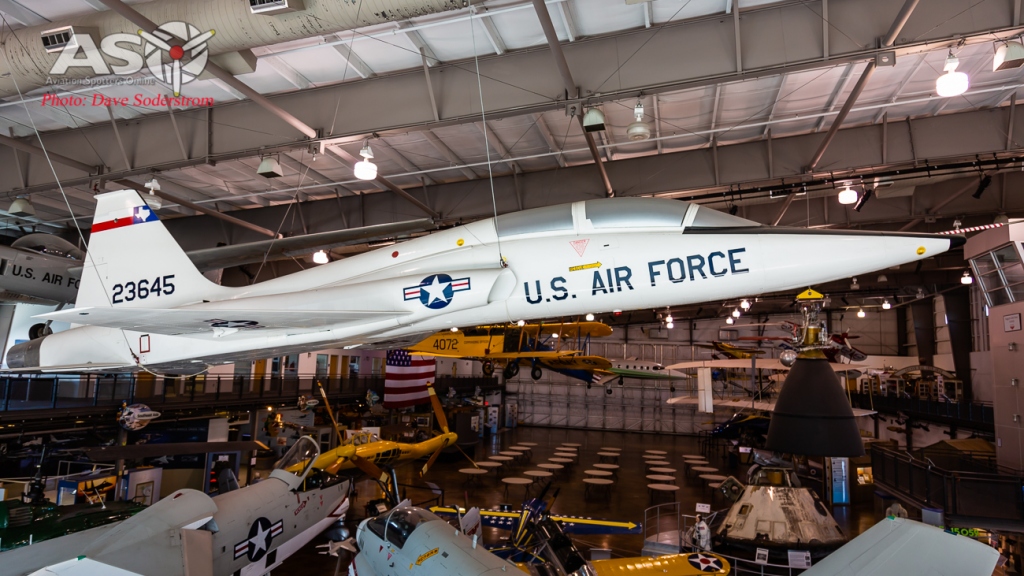

Pitts S-2B
Designed by Curtis Pitts in the early 1940s as a high-performance aerobatic biplane, the Pitts Special came in two variants – the S-1 single seat or S-2 two-seat. First flown in 1944, the Pitts dominated aerobatic competitions in the 1960-the 70s and continues to be a popular aircraft for airshow pilots and spectators due to its outstanding maneuverability and performance.

Boeing 737-200
The Boeing 737-200 is the second model of Boeing’s popular 737 range. In 1965, Boeing needed a short-range jet and designed the 737 to complement their fleet of long-range 707 and medium-range 727 jets. The short-range Boeing 737 soon became the world’s best selling jet airliner. The six-foot longer fuselage on the 737-200 made it a favourite of airlines since it could carry more passengers than its predecessor model, the 737-100. Over the years and nine different models, Boeing continued to evolve the basic 737 design making it more fuel-efficient by changing its engines, wing design, avionics, and flight control systems.
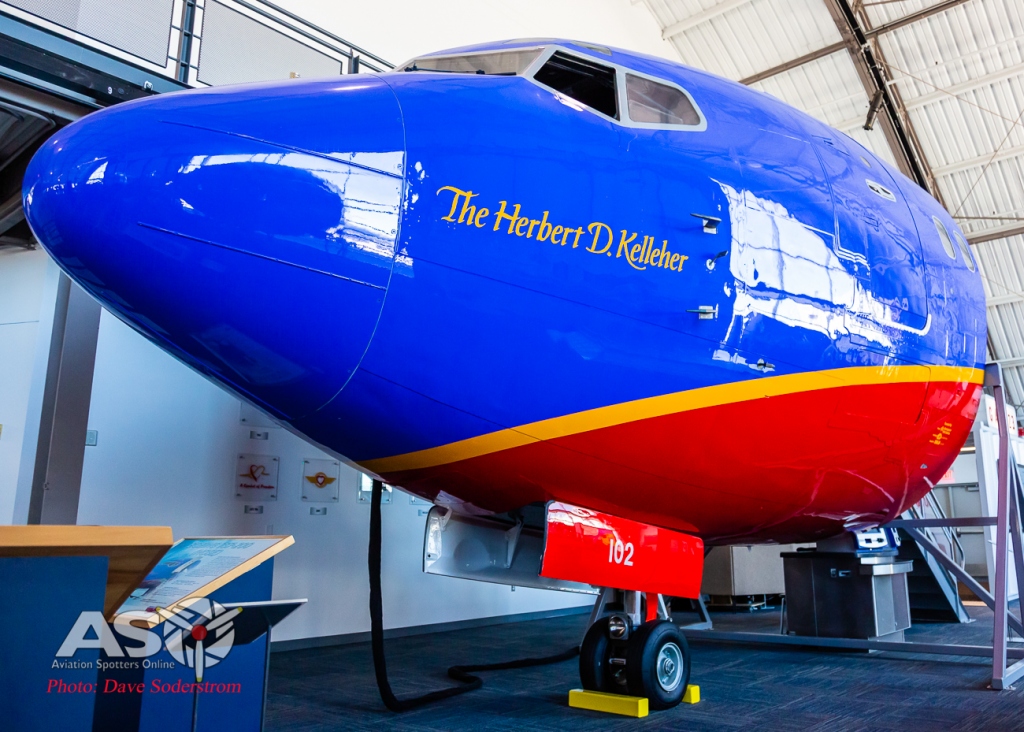 Entering service with Southwest Airlines in March 1984, this Boeing 737-200 N102SW retired in January 2004. Company volunteers worked diligently to make the perfect Museum exhibit — the front “slice” of the aircraft, including the cockpit, galley, and lavatory. Thanks to the vision and generosity of Herb Kelleher, Southwest Airlines Chairman, the renovated nose of N102SW became the centrepiece of the “Heart of Texas” Southwest Airlines exhibit when the Museum opened on Lemmon Avenue in May 2004.
Entering service with Southwest Airlines in March 1984, this Boeing 737-200 N102SW retired in January 2004. Company volunteers worked diligently to make the perfect Museum exhibit — the front “slice” of the aircraft, including the cockpit, galley, and lavatory. Thanks to the vision and generosity of Herb Kelleher, Southwest Airlines Chairman, the renovated nose of N102SW became the centrepiece of the “Heart of Texas” Southwest Airlines exhibit when the Museum opened on Lemmon Avenue in May 2004.
Boeing 737-300
The Boeing 737-300 is a twin-engine narrow-body commercial airliner, the initial model of the 737 Classic Series and the second generation of the 737-100 and 200 models. In the early 1980s, Southwest Airlines and US Air both approached the Boeing Company about a larger 737 model to meet their longer-haul flight expansions. The new 737-300 meet their needs for increased range and passenger/cargo capacities. With quieter more powerful engines, the 737-300 produced fewer pollutants than earlier engines.
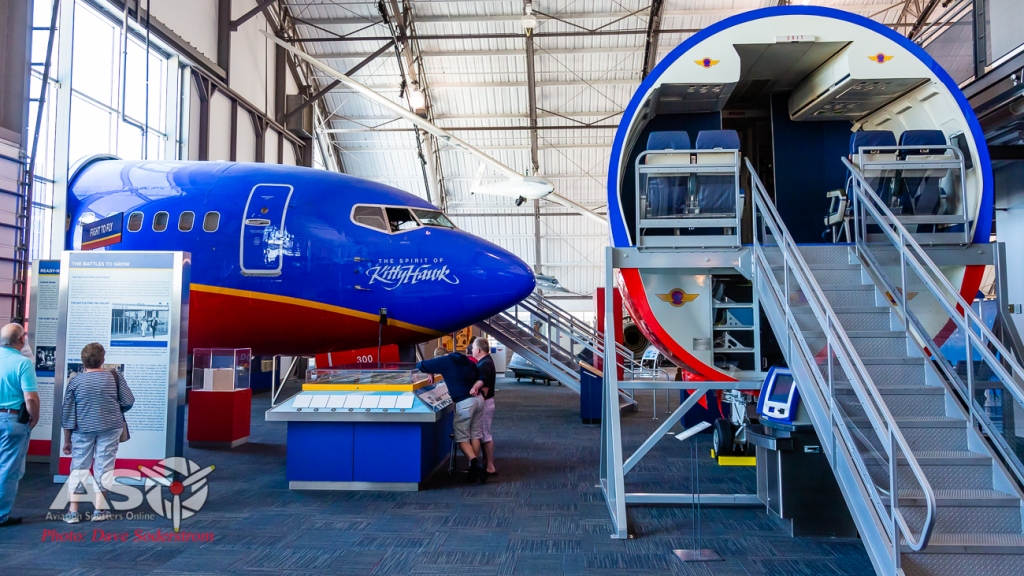 The very first of 1,113 Boeing 737-300 aircraft built and the very first in service with Southwest Airlines, N300SW first flew on 15 August 1984. On 18 April 2011, “The Spirit of Kitty Hawk” made her final flight after logging 83,132 hours of flight over 77,301 cycles. Generously donated by Southwest Airlines, this beautifully restored Boeing 737-300 is a premier historical exhibit, both inside and out. N300SW is now the cornerstone of the Museum and its Southwest Airlines Gallery.
The very first of 1,113 Boeing 737-300 aircraft built and the very first in service with Southwest Airlines, N300SW first flew on 15 August 1984. On 18 April 2011, “The Spirit of Kitty Hawk” made her final flight after logging 83,132 hours of flight over 77,301 cycles. Generously donated by Southwest Airlines, this beautifully restored Boeing 737-300 is a premier historical exhibit, both inside and out. N300SW is now the cornerstone of the Museum and its Southwest Airlines Gallery.
Republic F-105 Thunderchief.
Originally designed to meet America’s need for an exceptionally fast nuclear strike aircraft in the Cold War, the F-105D “Thunderchief” actually achieved the most fame in the Air War over the jungles of Vietnam. The largest single-engine combat aircraft at the time, the F-105 could carry 14,000 lbs of armament. Although this incredibly fast aircraft could reach Mach 1 at sea level and Mach 2 at high altitude, the F-105’s highly loaded wings did not provide much in the way of maneuverability. This made missions extremely dangerous and losses unacceptably high.
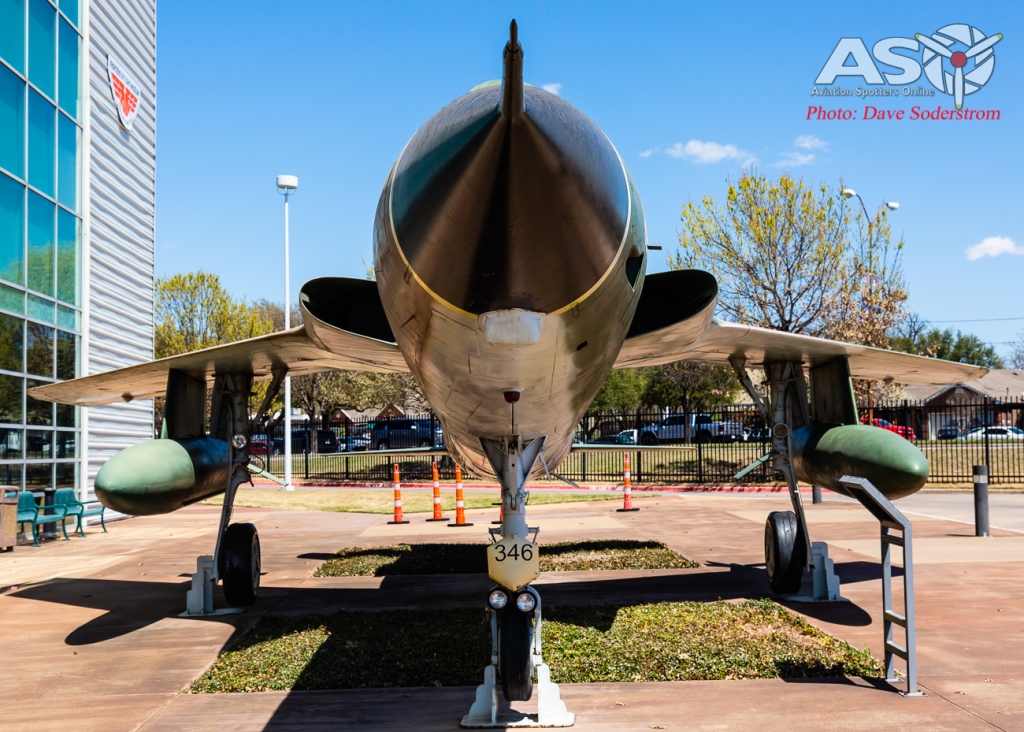
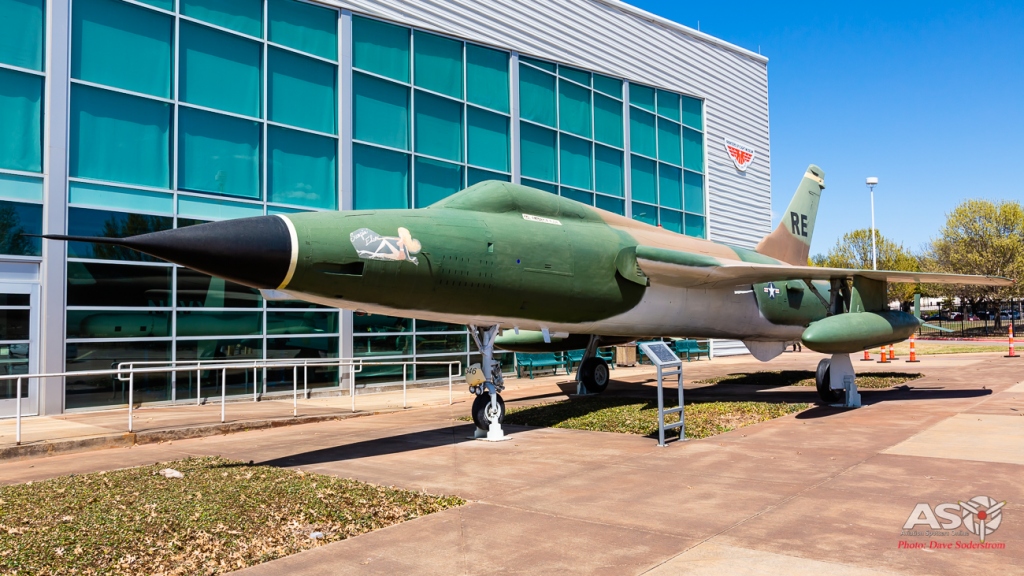 Steve Coker, friend of the Museum and former F-105D Driver, played a big part in getting this beautiful Republic F-105D, 62-4346, to the Museum. This aircraft is on loan from the National Museum of the US Air Force in Ohio.
Steve Coker, friend of the Museum and former F-105D Driver, played a big part in getting this beautiful Republic F-105D, 62-4346, to the Museum. This aircraft is on loan from the National Museum of the US Air Force in Ohio.

Learjet 24D
One of the first private jets in production, the sleek Learjet 24D became a favourite with its low-speed handling characteristics, increased range, size, and speed. The idea of eccentric inventor William P. Lear Sr, the aircraft met the need for a private luxurious jet aircraft that could fly in and out of small airports. Originally inspired by a single-seat Swiss strike fighter aircraft prototype, the FFA P-16, the 1965 Learjet 23 proved demanding to fly, so Lear quickly improved the design and released the ever-popular Learjet 24 in 1966.
 The 1973 Learjet 24D aircraft, N281FP, serial #281, faithfully logged a total of 7,330 airframe hours and 8,707 landings before being generously donated to the Museum by Valhi, Inc. of Dallas, Texas.
The 1973 Learjet 24D aircraft, N281FP, serial #281, faithfully logged a total of 7,330 airframe hours and 8,707 landings before being generously donated to the Museum by Valhi, Inc. of Dallas, Texas.
Lockheed T-33A Shooting Star
The Lockheed T-33A “Shooting Star,” based on the design of the P-80 “Shooting Star,” began training pilots as they transitioned from propeller-driven to jet aircraft at the end of World War II. Lockheed modified the design of a P-80C from one seat to two and added room for the trainer by slightly lengthening the fuselage. Originally designated the TP-80C, the T-33A made its first flight in May 1948. The old saying is, “every military jet pilot in the free world has spent time in a T-33.” It has flown with the air forces of more than twenty countries for over forty years.
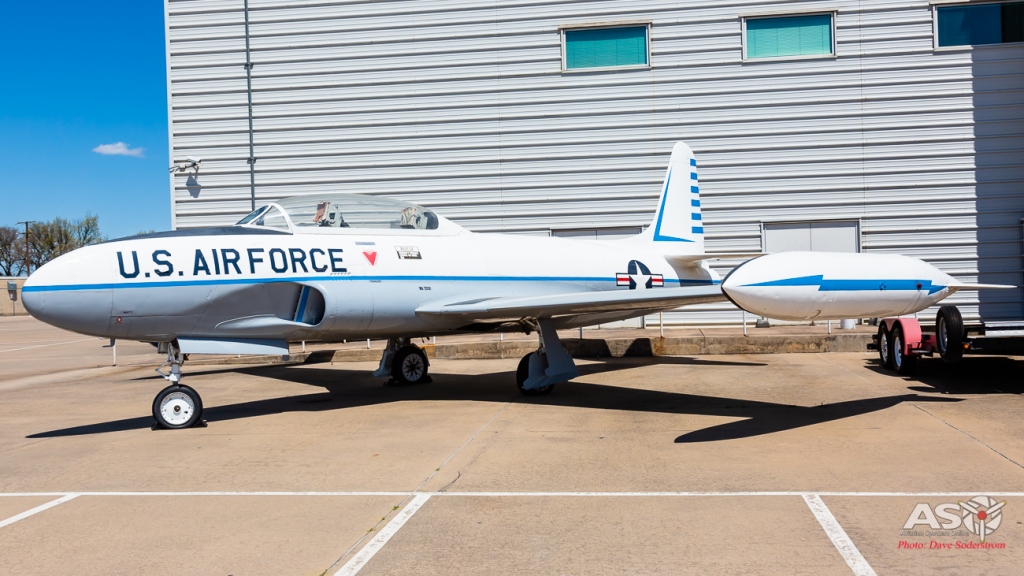
Originally delivered to the US Air Force in 1950 with serial #0-61767, our T-33 sports the livery of the last T-33 flown by the 48th Fighter-Interceptor Squadron at Langley Air Force Base in the late 1980s.
If you are ever in Dallas this is one aviation museum you must visit. The quality of the displays is excellent. The volunteers are extremely helpful and I hope to be back very soon to spend more time at this first-class museum.
For more information or to visit the museum its details are as follows:
6911 Lemmon Ave, Dallas, TX
(214) -350-3600
Info@flightmuseum.com


